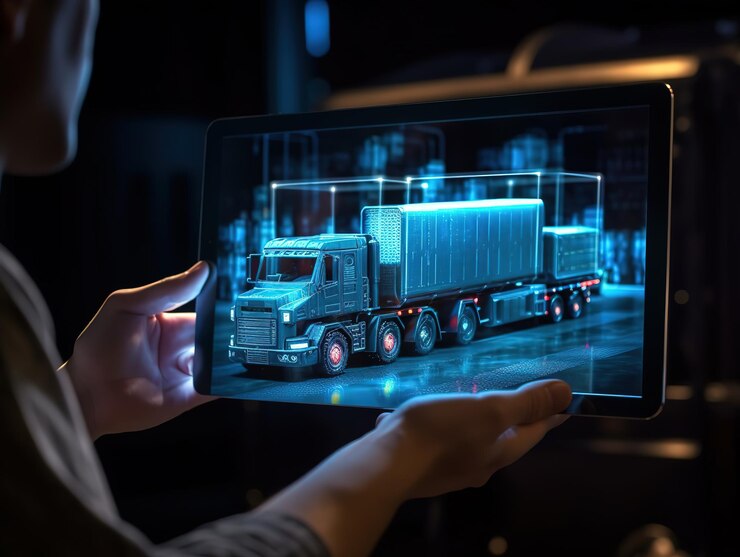The Role Of Technology In Solving The Truck Driver Shortage
6 Mins Read
Published on: 22 September 2023
Last Updated on: 10 September 2024

toc impalement
The trucking industry, a cornerstone of modern commerce, has grappled with a severe driver shortage for years. Factors such as an aging workforce, rigorous demands of the job, and rising transportation needs have exacerbated this crisis.
This truck driver shortage has broader implications than one might initially realize. With the vast majority of goods being transported overland, a shortage in drivers can lead to delays in deliveries, increasing costs for businesses and, subsequently, for consumers. The long hours, time away from family, and physical demands of loading and unloading heavy goods make it less appealing for younger generations, so is trucking a good career?
Furthermore, as the older generation of drivers approaches retirement, there isn’t a sufficient influx of new drivers to replace them. Recent regulations have also added layers of complexity to the profession, requiring drivers to strictly log their hours and ensure they get the requisite rest, which, while designed for safety, has sometimes deterred potential drivers.
Additionally, the evolution of e-commerce has skyrocketed the demand for shipping, putting even more pressure on an already strained workforce. Solving this issue requires a multi-faceted approach, and technology seems to be one of the promising avenues to address it.
Technological Innovations Tackling The Shortage

Driver Assistance Systems:
The dawn of smart vehicles brought forth a range of driver assistance systems tailored for the trucking industry, aiming to address key challenges contributing to the truck driver shortage. These systems, often a combination of cameras, sensors, and sophisticated algorithms, monitor various parameters to ensure safe driving.
For instance, lane-keeping prevents unintended lane departures, a common cause of accidents, especially during long, fatiguing drives. Automated braking systems can detect potential collisions and apply brakes if the driver fails to react quickly.
Additionally, these tools significantly reduce drivers’ stress levels by continuously providing them with a second set of eyes, effectively minimizing the chances of human error. By enhancing overall safety, these technologies can make the profession more appealing, possibly drawing more individuals to consider truck driving a viable career option.
Autonomous Trucks:
The concept of autonomous vehicles, once a science fiction dream, is fast becoming a reality, and its implications for addressing the truck driver shortage are profound. Companies globally are investing billions into the research and development of self-driving trucks. While the current focus is creating trucks that can autonomously navigate highways, the end goal is a complete door-to-door delivery system without human intervention.
These autonomous trucks can operate around the clock, unaffected by human factors such as fatigue, thereby significantly boosting efficiency and reducing delivery times. By reducing the reliance on human drivers for long hauls, the trucking industry can repurpose human skills for more intricate tasks that machines cannot yet handle, such as navigating busy city streets or handling sensitive cargo.
It’s a significant step towards mitigating the truck driver shortage, as fewer drivers will be needed for long-haul routes, allowing the available workforce to cater to more regional or specialized tasks.
Virtual Reality for Driver Training:
Training new drivers is a considerable investment for companies. Traditional methods often require dedicated instructors, actual trucks, and on-road sessions, which can be costly and time-consuming. Virtual Reality (VR) is revolutionizing this process. Instead of learning in actual trucks, novices can now train in virtual environments that mimic real-world conditions.
This immersive experience allows trainees to encounter diverse scenarios, from driving in adverse weather conditions to navigating through peak traffic, all in a controlled and risk-free setting.
Such VR training modules can accelerate the learning curve and ensure that when drivers do get behind the wheel of an actual truck, they are better prepared and confident. This modern approach reduces training costs and provides a solution to the truck driver shortage by producing competent drivers faster than traditional methods.
Benefits of Adopting Technology in Trucking
Integrating technology into the trucking industry not only addresses the truck driver shortage but also offers many other benefits. With the introduction of intelligent systems and automated processes, the industry is witnessing a transformative shift in its operations.
One of the most notable benefits is the increase in road safety. Advanced driver assistance systems, such as lane departure warnings and automatic braking, have significantly reduced the chances of accidents caused by human errors or fatigue. This protects the drivers and ensures the safety of other road users, leading to a comprehensive reduction in road casualties.
From an economic perspective, adopting technology translates to tangible savings for the industry. Fewer accidents mean reduced costs related to vehicle repairs, insurance claims, and potential legal liabilities. Furthermore, features like fuel optimization and route planning algorithms lead to more efficient journeys, thereby reducing operational costs.
Moreover, with the aid of technology, the industry can better meet the growing transportation demands. As e-commerce continues its upward trajectory, reliable and timely transportation becomes paramount. Advanced logistics platforms powered by artificial intelligence can forecast demands, optimize routes, and ensure timely deliveries, enhancing customer satisfaction.
While technology is invaluable in tackling the truck driver shortage, its overarching impact extends far beyond, promising a safer, more efficient, and sustainable future for the trucking industry.
Related: Essential Safety Strategies For Truck Drivers After A Truck Accident
The Road Ahead: Future Prospects
The realm of transportation is on the brink of a technological renaissance, and its impact on addressing the truck driver shortage is just one facet of this transformation. As technology evolves, its role in resolving the driver shortage will become even more pronounced. Already, preliminary trials of autonomous trucks are hinting at a future where self-driving vehicles might dominate long-haul routes, requiring human intervention only for last-mile deliveries or in complex terrains.
This prospect doesn’t necessarily mean eliminating truck driving jobs but rather a shift in their nature. Drivers may transition to roles of vehicle supervisors or fleet coordinators, overseeing autonomous operations and stepping in only when necessary. Moreover, enhanced VR training modules could allow for continuous skill upgrades, ensuring that drivers are always equipped with the latest knowledge and expertise without the traditional time and location constraints.
Another promising frontier is the integration of the Internet of Things (IoT) in trucking. Advanced sensors can monitor vehicle health in real-time, predict maintenance needs, and even help optimize cargo conditions, ensuring goods are transported in their best state.
Furthermore, as environmental concerns grow, technology could lead the charge in introducing electric truck fleets, contributing to a greener transportation landscape.
Conclusion
The truck driver shortage has been a looming shadow over the transportation industry for years, threatening the seamless movement of goods and services that fuel our global economy. Yet, as with many challenges of the modern age, technology emerges as a beacon of hope, offering innovative solutions to age-old problems.
Integrating cutting-edge systems, from autonomous vehicles to sophisticated driver assistance tools, brings renewed optimism. Not only do these advancements provide tangible avenues to address the truck driver shortage, but they also mark the dawn of a new era in transportation.
This transformation is not merely about replacing human roles with machines. Instead, it’s about augmenting human capabilities, ensuring drivers are better equipped, better trained, and safer on the roads. As technology continues to advance rapidly, its role in shaping the future of trucking becomes undeniable. It promises a short-term solution to the current crisis and a long-term vision of a more resilient and adaptive industry.
Read Also:


















Comments Are Closed For This Article